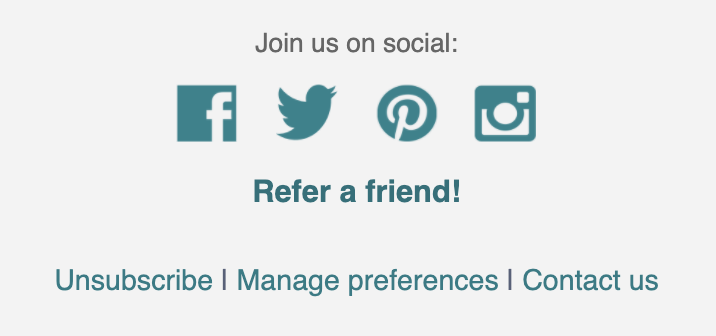Cheetah Digital discuss Refer-a-Friend programmes.
Important note: We are not lawyers. This is not legal advice.
At the bottom of any email newsletter, you might see a link inviting you to share the email with a friend. It seems like a helpful feature, a win-win for brands and customers alike — customers can easily share the email while brands can add an email address to their database without having to do anything at all.
How do Refer-a-Friend programmes work?
A bit of background first. Refer-a-Friend (RAF) is one of the oldest “viral” marketing strategies and a helpful way for brands to increase their reach — word-of-mouth is one of the best methods of marketing. Friend groups often have similar interests, so it’s likely that if the customer likes a product or service, their friend would too.
Brands make this sharing easy, by providing a link in their email that can look something like the picture below. It opens to a new page where the customer can add the email addresses of the friends they think would enjoy the offering.

Who’s responsible for the RAF email?
There are a number of considerations and a few paradoxes at play here.
- Who initiates the message? In other words, who sits behind the wheel? Industry wisdom dictates the marketer should sit quietly in the back seat. You provide the car (the message), the keys (the referral mechanism), and the road (Cheetah tech) and let the referrer do the driving. Wonky terminology varies, but ask your legal advisors about “routine (passive) conveyance mechanisms.”
- Who is the message “from”? Rather, whose name should be in the “Friendly from” — the driver’s. Remember, you are in the back seat and going along with the ride. Nevermind that the car is yours. Who wants to see some stranger roll up into their driveway?
- What if I incentivise the referral? If you incentivise the referral and not the conversion, you may be putting yourself into the driver’s seat. Wonky terminology varies, but ask your legal advisors if incentivisation equals “procurement” equals compliance responsibility in the jurisdiction where you wish to offer RAF. Major catch-22? Being held responsible for sending an unsolicited commercial email (“UCE”) where prior consent or an existing business relationship is required.
Can I contact referred individuals?
Don’t be hasty. You would need necessary legal rights and permissions to go direct right away. You may not know or be in a position to know that any of these individuals are existing customers or subscribers in good standing. Or, that they wish to hear from you directly… remember, RAF is not a lead generation effort — it is a way for your customers and influencers to evangelise your brand. The last thing you’d want to do is jump the gun and wind up with spam complaints instead of new subscriptions. (You may also find yourself at odds with applicable laws as well as our Global Anti-Spam Policy and service terms.)
Can you share some RAF best practices?
- Only friends should email friends. Personalise the “Friendly from” and message body to make that clear.
- Make the referrer the hero of the story. Let them tailor the message (eg, “these two purchases were my favorite” <link> <link>).
- With RAF webforms or Experiences, turn on encryption, add Captcha, prohibit address book uploads, and provide your privacy notice.
- Check submitted emails for obvious syntactical errors, but not against your CRM. This is privacy invasive.
- Don’t auto-subscribe RAF recipients to your mailing lists. Do include a newsletter subscription button or banner. It never hurts to ask.
- Reward the conversion, not the referral (eg, 10 per cent off for you and your friend with their next purchase).
- Consult with appropriate legal counsel. RAF programmes are permitted in some jurisdictions but not others and may have unique privacy-compliance considerations that should not be ignored.

